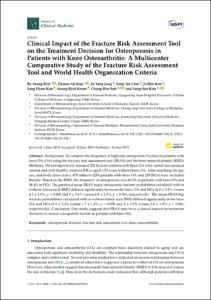KUMEL Repository
1. Journal Papers (연구논문)
1. School of Medicine (의과대학)
Dept. of Internal Medicine (내과학)
Clinical Impact of the Fracture Risk Assessment Tool on the Treatment Decision for Osteoporosis in Patients with Knee Osteoarthritis: A Multicenter Comparative Study of the Fracture Risk Assessment Tool and World Health Organization Criteria
- Keimyung Author(s)
- Kim, Ji Min; Kim, Sang Hyon
- Department
- Dept. of Internal Medicine (내과학)
- Journal Title
- Journal of Clinical Medicine
- Issued Date
- 2019
- Volume
- 8
- Issue
- 7
- Abstract
- Background:
To compare the frequency of high-risk osteoporotic fracture in patients with knee OA (OA) using the fracture risk assessment tool (FRAX) and the bone mineral density (BMD).
Methods:
We retrospectively assessed 282 Korean patients with knee OA who visited five medical centers and 1165 healthy controls (HCs) aged 50 years without knee OA. After matching for age, sex, and body mass index, 478 subjects (239 patients with knee OA and 239 HCs) were included.
Results:
Based on the BMD, the frequency of osteoporosis was 40.2% in patients with knee OA and 36.4% in HCs. The predicted mean FRAX major osteoporotic fracture probabilities calculated with or without femur neck BMD di ered significantly between the knee OA and HCs (6.9 3.8% versus 6.1 2.8%, p = 0.000 and 8 3.6% versus 6.8 2.3%, p < 0.001, respectively). The mean FRAX hip fracture probabilities calculated with or without femur neck BMD di ered significantly in the knee OA and HCs (2.1 2.4% versus 1.7 1.8%, p = 0.006 and 3 2.3% versus 2.4 1.6%, p < 0.001, respectively).
Conclusion:
Our study suggests that FRAX may have a clinical impact on treatment decisions to reduce osteoporotic facture in patients with knee OA.
- Publisher
- School of Medicine (의과대학)
- Citation
- Bo Young Kim et al. (2019). Clinical Impact of the Fracture Risk Assessment Tool on the Treatment Decision for Osteoporosis in Patients with Knee Osteoarthritis: A Multicenter Comparative Study of the Fracture Risk Assessment Tool and World Health Organization Criteria. Journal of Clinical Medicine, 8(7), 918–918. doi: 10.3390/jcm8070918
- Type
- Article
- ISSN
- 2077-0383
- Source
- https://www.mdpi.com/2077-0383/8/7/918
- Appears in Collections:
- 1. School of Medicine (의과대학) > Dept. of Internal Medicine (내과학)
- 파일 목록
-
-
Download
 oak-2019-0173.pdf
기타 데이터 / 909.13 kB / Adobe PDF
oak-2019-0173.pdf
기타 데이터 / 909.13 kB / Adobe PDF
-
Items in Repository are protected by copyright, with all rights reserved, unless otherwise indicated.